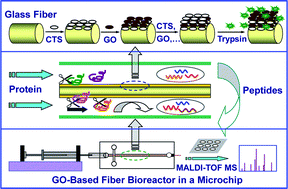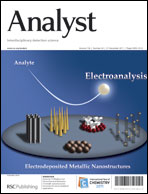In this report, trypsin was immobilized in the layer-by-layer (LBL) coating of graphene oxide (GO) and chitosan on a piece of glass fiber to fabricate microchip bioreactor for efficient proteolysis. LBL deposition driven by electrostatic forces easily took place on the surface of the glass fiber, providing mild environmental conditions so that the denaturation and autolysis of the immobilized trypsin was minimized. Prior to use, a piece of the prepared trypsin-immobilized glass fiber was inserted into the channel of a microchip to form a core-changeable bioreactor. The novel GO-based bioreactor can be regenerated by changing its fiber core. The feasibility and performance of the unique bioreactor were demonstrated by the tryptic digestion of bovine serum albumin, myoglobin, cytochrome c, and hemoglobin and the digestion time was significantly reduced to less than 10 s. The obtained digests were identified by MALDI-TOF MS. The digestion performance of the core-changeable GO-based microchip bioreactor was comparable to that of 12-h in-solution tryptic digestion. The novel microchip bioreactor is simple and efficient, offering great promise for high-throughput protein identification.

You have access to this article
 Please wait while we load your content...
Something went wrong. Try again?
Please wait while we load your content...
Something went wrong. Try again?


 Please wait while we load your content...
Please wait while we load your content...